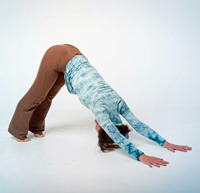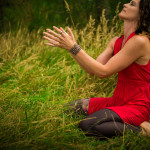by Kara-Leah Grant, author of Forty Days of Yoga
In the 40,000 words of Forty Days of Yoga I give no specific instruction on asana or set sequences. That means that if you’re looking for a home yoga practice book that will tell you what to do, this is not it.
I know – you’re looking for a magic bullet. That perfect home yoga practice that will turn you into a yogi.
I know this because at workshops and in classes, via email and in comments, student after student after student asks me, and other teachers:
‘What’s your home practice like?’
Students have this idea that there is an ideal home yoga practice, and if they could just find out what it is, they’d be able to practice it and all would be well. Hopefully this Ideal home yoga practice would be short-ish, easy-ish and work miracles on body, mind and soul.
But you know what?
There is no standardized ideal home yoga practice. There is only the ideal home yoga practice for you.
What that is depends on many factors, including your body, your stage of life, your living environment, your work environment, your culture, your climate… your everything.
That’s why I can’t tell you what to do. And I know that this can be really scary, and one of the major reasons why we don’t commit to our home yoga practice.
We’re afraid to face the unknown.
We’re afraid to feel like we don’t know what to do.
We’re afraid to feel unsure, uncomfortable, useless and hopeless.
Committing to a regular home yoga practice means we develop the courage to step into these states of being and stay with them.
We learn to be ok with the unknown, with not knowing what to do. We’re ok with feeling unsure, uncomfortable, useless and hopeless.
This is gold right there. That courage to be in uncomfortable states of being bleeds out into the rest of our life.
However, it is daunting at first. It can be so daunting it can keep us off our mat. So I’ve developed a technique I call The Anchor which gives me something to start my practice with – something simple and comforting and known.
It means I don’t have to ‘think’ about what to do, ‘worry’ about what to do… I just get on my mat and I do it. Invariably, getting on my mat and doing my Anchor practice leads into all kinds of other exploration based on what I currently need to come back into balance.
The Anchor also functions as an antidote to avoidance.
Going with the flow in a home practice and intuiting what the body needs is all good and well. It works great. But it also creates space and possibility for avoidance – edging away from practices that we need most because they challenge us.
Lately, my home practice has consisted mainly of pranayama, yin-style floor asana and meditation. Bluntly, I sit and stare at my navel a lot. I love it.
However, all that navel-gazing can suck me up into my Mind and send me spiralling into unhealthy states of being.
Recently, I realised that maybe I’d been avoiding a stronger asana practice. It had been months since I’d done any sun salutations and they used to be the mainstay of my practice. I hadn’t even been teaching them in my classes.
Time for some honest self-inquiry and a small experiment.
On a day filled with Mat Resistance, I forced myself to start my practice with five sun salutations.
And it was forced. I sooooooo didn’t want to. That in itself was interesting. Any time we’ve got a strong reaction against doing something… well, it’s worth exploring. What’s really going on there?
I did my five sun salutations. I noted how different it felt. All kinds of energy lines (nadis) were being activated or felt that I hadn’t sensed in a long time. There was physical discomfort, emotional discomfort and mental discomfort.
Oh yes, this is where I needed to be.
So I’m now on a Forty Day practice using five sun salutations as An Anchor.
This means that every single day, no matter what, I will do five sun salutations. That is the bare minimum must-do of my practice. It ensures I face up to my avoidance. It means my practice starts with a strong asana focus, which is what I need for balance right now.
Balance – that’s the key to your home yoga practice. That’s why there is no standardised perfect home yoga practice for everybody.
Your home yoga practice is there to serve you by bringing you into a state of balance and what you need to find balance is different to what I need and different to what the elderly woman down the street and the hot school teacher across the park needs.
Choosing and committing to an Anchor that balances you and possibly deals to avoidance gives you a solid foundation for your daily practice, no matter what else you do.
Then, what else you do doesn’t matter. It can be fluid and free and exploratory and playful and light. You’ve anchored yourself. You’ve balanced yourself. All that follows is gravy.
Like the sound of developing your home yoga practice this way? Maybe you need Forty Days of Yoga. On sale now.


Leave a Reply